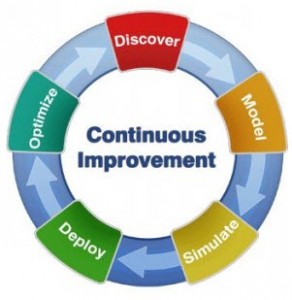| One of the most effective Project Management Tools |
 A project manager works in a strange environment when it comes to people reporting to them. Typically, companies are set up as a matrixed organization where the people necessary to complete a project are managed by someone other than the project manager. The person that manages these people is responsible for their schedules, vacation approvals, raises, performance review, and general departmental direction. And YOU are responsible for getting the job done with their help. You have a temporary, ethereal, dotted-line to this person for a brief moment in time to complete a project. No more, no less. You don’t approve their vacation, you don’t give them raises, and you don’t score them on their performance review. You just give them work to do! How does that work? You can have all the project management tools in the world at your disposal and this still doesn’t seem like an equitable situation for a project manager. This is what you do. You throw in the towel on managing the people (that’s someone else’s job) and focus on managing The Process instead. The Process for getting something done is what you DO own as a project manager and something you can create, refine, and adjust. You will find that The Process is one of the most powerful project management tools you can have at your disposal. Manage The Process, not the people should be your daily mantra. Here are some reasons why and what you can do to optimize The Process in your company. The Process is a Powerful Project Management Tool You “own” very few things as a project manager. One thing you can claim as your own is your methodology and process for getting projects done. If you are part of a larger company that has a PMO, this process may be handed down to you from above. If you are part of a smaller company with a handful of project managers, then this is something you can pull together on your own or with the assistance of your colleagues. Either way, you should wholeheartedly grab hold of the process as something you own and manage directly.
 If you are starting from scratch, you can pull this powerful project management tool together by basing it upon your years of experience in whichever industry you are managing projects. The final process will be a blend of your experience in that industry, your experience as a project manager, varied and different project management methodologies and some of the best of the best advice you have received from your peers and colleagues on how they effectively manage projects. The thing to keep in mind throughout this is that you are the rightful and dedicated owner of the process and it is up to you to make it work to the best of your abilities. Putting The Process together If you are in the enviable position of starting from scratch (enviable in the sense that you do not have to undo what someone else has done), then the best place to start is with what you know. Map out how you know the projects currently flow today and start making notes along the way of what can be refined or improved. Start with the largest components of the process which will usually be phases. A project will move from one phase through the next as it is completed. This will typically start with some type of requirements phase, move into building, testing, deployment and then maintenance. These phases will vary from industry to industry, but they will follow the above flow as a general rule of thumb. Then you can map out what should typically be completed in each phase. What should be the final “product” or output that comes from the requirements phase or testing phase for example? Tie this into certain checkpoints, approvals, or other documentations that are already in place or that you know should be in place. Finally, map this out in an easy to understand way such as a swimlane diagram, flowchart or some other means of communicating the process that you believe will be effective with your team. You now have a great start to socialize the process (that you own) to the people on your project (that you do not manage directly). Getting buy-in on your new project management tool It’s just as important to get buy-in from the people who will be following the process as it would be to get buy-in on any project management tool.
 This is your opportunity to meet with some or all of the team and lay it out for them. You will undoubtedly have had conversations with these people’s managers prior to this meeting in order to explain to them what you are doing and why. These managers would then be able to address any concerns or questions that may come up directly from their team. Lay out the flow for the team and then brace yourself. You will hear comments such as “That will never work. Do you even know what you are talking about? You missed an entire piece of what we do in this process.” Great! That’s exactly what you want to hear. Take this opportunity to thank everyone for their input and explain that that was the reason for this meeting. You didn’t want to create a process in a vacuum without getting the proper feedback from those who will be expected to follow the process. This does two things. First, it makes the process viable and second, it lets people know that you are concerned about their opinions and viewpoints and they will be more likely to support the new or revised way of doing things. Implementing the Process Just as with any great project management tool, the process will do nothing unless you implement it across the organization. You are now in a great place to do this. You have based the process upon your experience, received feedback from the team and have now established the rules of the game. You don’t need to worry about managing the people anymore as they all understand how the game is played. You are the dedicated owner of the process and that is how you get your projects done.
 Something amazing happens at this point as well. There will be those who embrace the process and those who do not. Those who embrace the process will realize that following it makes their job easier. They will pull their chairs up closer to the process table and be engaged. They will offer suggestions for improvement, make recommendations on those areas that may be a waste of time, and generally be accepting the way the game is played. On the other hand, there will be those who despise the process. They feel as if it takes away some of their independence or flexibility in how they work. You will find that they will begin to push themselves away from the process table. That’s fine. Over time these people will either accept that following a process is a much better way of doing things, or they will begin to move on to other opportunities. This leaves a team of professionals who are engaged in the process and great at what they do. Rather than stress about what you can’t control or manage (the people), focus your energies on what you can control and manage (the process). You will find your reputation as a project manager soar as you quickly have the ability to bring new people in and out of the process and bring them up to speed in no time at all! |



